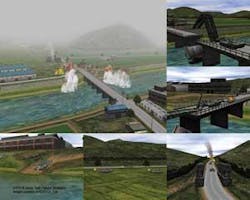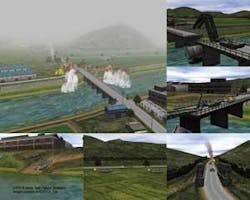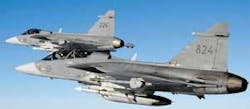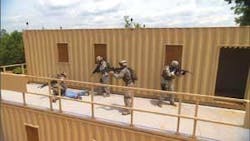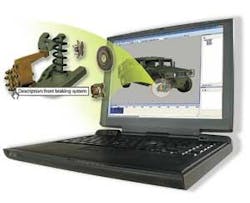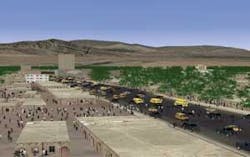Commercial off-the-shelf hardware and software elements advance military simulation, training, and mission-rehearsal systems.
By Courtney E. Howard
Effective training and mission rehearsal have long been integral to mission success and warfighter safety, yet, they are perhaps more important today than ever before.
Many global and political empires are in flux, shifting power and focus, while also expanding and upgrading their militaries. For example, U.S. special operations forces are investing energy and resources into transforming Iraqi soldiers into a well-trained command. At the same time, much has been written about Russian and Israeli soldiers, who are purported to be among the best trained in the world.
It is little wonder, then, that warfighter training and mission readiness have become focal points and growing areas of investment for many international military organizations today.
Readiness through training
Increased mission success is just one, albeit important, benefit of training and mission-rehearsal practices. The protection of human life is another, says Gary Beerman, director of real-time product management at Concurrent Computer Corp. in Duluth, Ga. “The quality of military readiness can mean the difference between human life and death.”
“Emergency procedures, such as an engine-out procedure in a commercial airliner with an emergency landing to a non-scheduled airport, can be rehearsed in the safety of a simulator,” adds John Archdeacon, co-founder and vice president of product marketing, customer service, and programs at Quantum3D in San Jose, Calif.
“Even longer and more complex missions, such as landing a spacecraft on the moon or rescuing a downed crew in an extremely hostile territory, can all be simulated to help familiarize the user with the world they may have to face in reality in the days ahead,” Archdeacon continues. “With the right simulation tools, components, and virtual environment, the user can practice or rehearse what otherwise might be too dangerous or too costly to try in the real-world for the first time, or even the second, third, or nth time.”
Commanding COTS
Military organizations are increasingly adopting commercial off-the-shelf (COTS) hardware and software components in various applications. Systems designers and developers serving military customers are no different in this regard; developers of military simulation and training systems and solutions are tapping COTS technology to keep costs in check and take advantage of commercial hardware and software innovations.
“The military is mandating the use of COTS technology for simulator development and deployment,” Beerman says. “COTS technology is affordable, abundant, and accessible. COTS components facilitate faster assimilation of technology for military systems. Military applications can use the technological and commercial success of many consumer products in gaming and simulations.” As examples, Beerman cites such COTS hardware as high-performance graphics cards, multi-core processors, and non-uniform memory architecture (NUMA).
Officials at Hyundai Rotem in Seoul, South Korea, have adopted COTS-based visual systems from Concurrent for their work on South Korea’s K-Series Tank Platoon Simulator (KTPS) program. Hyundai Rotem is the main contractor of the KTPS program, expected to strengthen Korean defenses.
KTPS virtual tactical tank simulation trainers, developed under the Defense R&D Program of Korea Defense Acquisition Program Administration (KDAPA), employ 32 Concurrent ImaGen visual servers powered by the company’s RedHawk Linux real-time operating system (RTOS) as the image-generation engine. Each tank simulator’s ImaGen configuration includes eight channels running Vega Prime COTS visualization software from Presagis in Montreal.
The hardware and software components combine into a scalable, high-fidelity, COTS-based, PC image-generation (PC-IG) system, says a representative. To date, Concurrent’s ImaGen PC-IG solution has been adopted by Luke Air Force Base/Lockheed Martin, Redstone Arsenal, Hyundai Rotem for the KTPS program, and Saab Aerosystems for the Gripen Simulator program.
Open and affordable
“Affordable reality is key,” says Quantum3D’s Archdeacon. “Gone are the days of proprietary simulation hardware technology and databases for military simulation and training. Instead, modern simulator providers must employ affordable and maintainable COTS technology to help keep simulator costs low and remain competitive.”
Quantum3D engineers harness COTS technology and open-architecture solutions to deliver real-time visual simulation and training systems to customers, such as Lockheed Martin, Raytheon, and Thales Training and Simulation. The company delivers “affordable reality” to military customers by combining mainstream PC-based technologies–Nvidia graphics cards, Intel microprocessors, and operating systems from Microsoft, Red Hat, and Wind River–with its own value-added image generator (IG) technologies, software, and services.
COTS technology is so important to today’s systems, in fact, that U.S. Air Force officials commissioned the National Aeronautics and Space Administration (NASA) in Washington to study the value of COTS in simulation and training applications. For this project, personnel at NASA Ames Research Center in Mountain View, Calif., sought to understand whether a flight simulator with an eye-limiting resolution out-the-window visual system could be built using COTS technology.
“The two-year study concluded that it could be, but the results pointed to a specific set of needs with respect to image generation and projection of flight simulators,” Archdeacon explains. “Most COTS high-definition (HD) projectors and monitors introduce a negative artifact called motion-induced blur that is caused by response time (rise/decay of pixel illuminance) and hold-time (the amount of time each pixel is illuminated per refresh). These factors make standard PCs, and even standard HD projection systems, insufficient when developing simulations designed to test pilots’ reaction time.”
NASA Ames personnel, armed with a Sony SRX projection system and Independence 4000 Image Generator from Quantum3D, demonstrated to U.S. Air Force officials how motion-induced blur could be prevented. As a result, proof positive exists that a realistic, accurate, COTS-based simulator would be effective for Air Force pilot testing.
“The importance of an image generator lies in its ability to compute the image that the pilot would see in an out-the-window scene,” Archdeacon explains, noting the growing importance of technology that works with the human anatomy. “Eye-limiting resolution and display technology is a relatively new requirement that we will see in future training and simulation applications.”
360-degree view
Companies, such as Mersive Technologies Inc. in Lexington, Ky., are overcoming eye limitations in training and simulation solutions with display technologies. After all, higher-resolution displays lend to an higher-fidelity training and simulation experience.
“Ultimately a display system should be capable of achieving 20/20 visual acuity,” explains Randall Stevens, president and chief executive officer at Mersive Technologies. “Using the multi-projector approach, these types of fidelities can be reached.” He notes that although the use of multi-projector displays is not new, clustering more than three to five projectors to form a seamless display environment is novel.
Mersive officials are working with Lockheed Martin engineers to deliver a solution for their Joint Terminal Attack Controller (JTAC) Virtual Trainer Dome simulators. Each dome-based simulator uses 13 to 14 projectors to achieve a realistic display environment. Mersive’s Sol Server software, primarily targeted at the military industry for advanced simulations, analyzes the display blended from several separate projectors and automatically aligns and calibrates the numerous images to produce one seamless vision.
Lockheed Martin engineers can reduce what used to take several weeks to set up to less than an hour with the use of the Mersive Sol Server, Stevens says. To help create affordable, realistic simulation and training environments, the software removes manual setup and allows display systems to be setup quickly and to maintain quality over time.
“Customers in these markets are looking for cost-effective solutions while increasing display fidelity,” says Stevens. “By automatically aligning an unlimited number of projection sources, customers in military and aerospace markets are able to create and maintain high-resolution displays at a fraction of the cost.”
For an immersive simulation experience, Mersive also offers a multi-projector display wall that delivers high-resolution, self-contained simulation and training. These m-Series displays have garnered interest from military and aerospace professionals for sniper training, after action review (AAR), and engineering collaboration applications.
Mersive officials have demonstrated a 360-degree, ultra-high-definition Humvee simulator. Ten projectors and the company’s Sol technology combine to display a seamless panorama environment. The hardware and software accommodates virtually any number of projectors and any shape or size projection surface, as well as enables three-dimensional applications, such as flight simulators.
Training takes flight
Students of F AIR Ltd., one of the Czech Republic’s largest private training schools, are undergoing flight training with the Ascent Flight Trainer from Mechtronix Systems Inc. (MSI) in Montreal.
The high-end Multi Crew Cooperation (MCC) training platform employed at the school is configured as a multi-engine turboprop, but it is reconfigurable to a multi-engine piston Piper Seneca V. It is equipped with a Garmin 430 GPS and uses a 150x35-degree visual system, including an RSI IG to provide high fidelity to real-world events and environments.
“We look at our purchase of the Ascent Flight Trainer with IR and MCC capabilities as a solid investment in the training of our students by adding to our training capacities,” says Martin Sýkora, F AIR Ltd.’s executive manager.
The technology is tailored to help F AIR Ltd. officials improve their student pilot provisioning programs, says Mechtronix president Xavier Herve. Czech Republic is a booming market for flight training, he says, and its airlines and FTOs demand flexible flight-training tools as they seek to provide newer and higher levels of pilot proficiency.
For the past eight years, Rockwell Collins in Cedar Rapids, Iowa, has delivered direct support to Naval Air Systems Command as the principal developer of simulation equipment for mission crew and maintenance training applications. According to a $68 million contract award, with a total target price of $164 million, Rockwell Collins officials will provide its E-2D Advanced Hawkeye Integrated Training System for Aircrew (HITS-A) to the U.S. Navy.
Fueling in mid-air
Refueling aircraft in mid-air while flying at top speeds is a daunting, yet vital task. Training to perform and perfect such a dangerous in-flight maneuver is equally important. For this reason, the Boom Operator Weapons System Trainer (BOWST) incorporates an advanced imaging solution. In fact, “the visual system is one of its most important components–the more realistic the view, the more authentic the experience,” says a representative of Christie Digital Systems USA Inc., a maker of professional display and visualization solutions based in Cypress, Calif.
The BOWST, a trainer designed to recreate the environment of a KC-135 aircraft, “helps Air Force boom operators acquire the necessary skills to perform their complex aerial refueling maneuvers hurtling through the air at hundreds of miles per hour. Lying on a cot and looking out of a small, rear-facing window in the belly of the craft, the operator learns to connect a long boom for transmitting gallons of flammable fuel to the receiving plane below,” describes a representative.
Officials with the U.S. Air Force and QuantaDyn Corp. in Herndon, Va., contracted Christie engineers to outfit the BOWST with a custom visual system and structure. Ten Christie Matrix 3000 DLP projectors power the BOWST’s compound spherical screen. This system, the second such unit to be constructed by Christie for the U.S. Air Force, is deployed at Altus Air Force Base, Okla. The Christie Matrix projectors deliver high-resolution imagery and a 220x55-degree field of view (FOV) for increased visual acuity.
“The visual system is a critical part of the trainer, contributing to the sense of realism for boom operators and pilots,” says William Dunn, president of QuantaDyn Corp., the prime contractor for the BOWST trainer. Christie’s projection systems “ensure a true-to-life experience for this high-fidelity training device. Christie’s AutoCal and ChristieTWIST technologies also played a crucial role in our decision. They offer exceptional ease of set-up and operation to precisely control and align several edge-blended images seamlessly on the spherical screen.”
Virtual combat
“Virtual training scenarios play a key role for soldiers trained at home and deployed to foreign countries,” says Nick Giannias, vice president of research and technology, at Presagis, a provider of COTS modeling, simulation, and embedded display graphics software. “For these trainees, it is important that they can become familiar with the geography of places like Iraq and Afghanistan before arriving, but also that they can understand cultural differences and the type of people, animals, and vehicles that they will encounter. This knowledge helps them to acclimatize before arriving and adapt quickly.”
Giannias and his colleagues at Presagis endeavor to provide today’s trainees with interactive visual information within training environments. “Developers meet these needs by creating stimulating scenarios that enhance the delivery of information and submerge soldiers and pilots in virtual surroundings,” he says. Tapping technologies and techniques from the commercial gaming industry, engineers are developing entities that behave intelligently, vehicles that move under a variety of physics-based models (such as wind and load), and life-like scenarios.
Lockheed Martin officials sought to upgrade two training systems in the U.S. Air Force’s Air Education and Training Command with the latest, advanced COTS technology. They called on engineers at Presagis and Concurrent to replace existing proprietary hardware and software with COTS products, including Presagis’s Lyra integrated 3D software and IG solution. Lyra provides pilots with a flying environment and sensor data in real time, Giannias describes.
The upgraded F-16 flight cockpit simulators are installed at the Networked Training Center (NTC) facility at Luke Air Force Base, Ariz. Each cockpit trainer features 11 out-the-window channels and three sensor channels, which emulate flight aspects like night-vision goggles and infrared technology. The trainers combine Presagis software and ImaGen visual servers in a multi-channel configuration powered by Concurrent’s RedHawk real-time Linux platform, compatible with Red Hat Enterprise Linux 4.
“Luke Air Force Base’s cockpit simulators demand a lot from our products and this upgrade opportunity is an excellent example of the strength and flexibility our COTS offerings provide in support of leading-edge training for the warfighter,” says Patrice Commune, president of Presagis.
COTS in combat
Operation Iraqi Freedom had a tremendous influence on military training, simulation, and mission-rehearsal techniques and technologies. Warfighters in the Global War on Terror had to adapt quickly to fighting in urban environments, something soldiers continue to do thanks to adaptable training solutions.
“Simulation, training, and mission rehearsal are critically important tools to overall operational readiness,” says Fred Pickens, senior director of business development for General Dynamics Information Technology (IT) in Fairfax, Va. “My 29 years of service the in U.S. Army taught me that it is challenging to stay abreast of the myriad of individual and collective tasks necessary for operational success, much less be ready to perform them. That is why simulation, training, and mission rehearsal are such important tools to a commander. These functions allow a unit to properly train for their wartime tasks.”
General Dynamics IT’s Integrated Instrumentation (I2) division delivers integrated instrumentation for urban operations training, and combat vehicle crew gunnery at live training ranges. The division, a primary provider of urban operations instrumentation for the U.S. Army’s Military Operations on Urbanized Terrain (MOUT) sites, has installed systems at urban assault courses, shoothouses, and Combined Arms Collective Training Facilities (CACTF), as well as the Army’s digital ranges for tank and Bradley gunnery. Aside from proprietary control software, the instrumentation is COTS.
General Dynamics IT’s I2 instrumentation creates a realistic battlefield environment for a training unit, records weapon engagements and all audio/video actions of the unit, and then enables a professional after-action review, Pickens continues.
Intelligence benefits training
Real-world data, such as intelligence gathered on the battlefield, can be invaluable to warfighter training and mission rehearsal.
“The best offense is a good defense,” says Robert Kopersiewich, vice president of product and program management, Presagis. “That’s why government agencies invest millions of dollars gathering data and using it to gain a competitive edge. Incorporating this intelligence–which can include mission plans, sensor information, geographic data, and cultural cues–into training simulations enables our military to increase mission success and reduce military and civilian casualties.”
Using simulations, warfighters can gain the upper hand by familiarizing themselves with different cultures and landscapes, and practicing missions before being deployed.
Military personnel from the different services, as well as primary contractors, are incorporating Presagis’s COTS software tools in solutions for mission-rehearsal applications, as well as after-action review and testing.
Training and mission-rehearsal systems can benefit from a variety of real-world intelligence gleaned from the battlefield, and vice versa. Data from real-world environments can be put into a simulation system for running various tests and scenarios, such as to help commanders and other decision makers refine their doctrines and tactics. Conversely, a weapon or tactic can be entered into the system and be tested in a simulated environment, including a digital battlefield, with no negative repercussions.
“The customer can model in our toolset an aircraft with a weapon system that doesn’t exist yet in the real world,” Kopersiewich describes. The company’s Vega Prime high-fidelity visual environment enables users to test the effect of strong wind, for example, on weapons systems. “It allows the customer to test a weapon system when it is still on the drawing board, make decisions, and ask contractors for modifications; it lowers the obstacles in terms of testing equipment and strategies on the battlefield.”
Today, military officials are requesting high-fidelity trainers for ground troops, to provide the level of training required to ensure soldiers are exposed to as little risk as possible, Kopersiewich adds. Convoy trainers or virtual convoys could train soldiers for situations they may come across in the field, such as an improvised explosive device (IED) detonating in an urban environment (see “Serious games help save lives on the battlefield,” pg. 1.). AI.implant, a multi-platform artificial intelligence (AI) authoring and runtime software from Presagis, might also add artificial intelligence to mission rehearsal systems, causing simulated crowds to react autonomously to the actions of the solder being trained.
Continued advancement
“With advances in technology, in particular COTS hardware and software, simulated training environments have become a tool in training and mission rehearsal efforts,” Giannias acknowledges. “Simulations easily integrate with information sources, can be adapted to a variety of mission objectives and tactics, and provide trainees with dynamic real-to-life scenarios.
“The visual quality of simulations has increased and are so detailed that visual cues, such as reflections on an aircraft wing or the wake of a ship, provide trainees with an immersive training experience that reflects the real world,” Giannias adds.
Continued advancement of COTS technologies–such as chip architectures, graphics cards, simulation software tools, and more–will continue at a rapid pace moving forward. Image generation systems will become smaller in footprint, provide higher fidelity with increased resolution, and have the capacity to process more information.
“Future technology can influence the future of training and simulation, offering greater overall features and value,” predicts Concurrent’s Beerman.
On-the-job and in-the-field training
“In the military, 65 percent of total cost of ownership for a piece of equipment–from cradle to grave–is spent on sustaining that equipment,” admits Gabe Batstone, vice president of sales and business development at NGRAIN Corp. in Vancouver, B.C.. These costs can be reduced, he says, by maximizing the effectiveness of equipment training programs and maintenance support systems with interactive 3D equipment simulations. “Ensuring personnel have the training and support needed to perform tasks right the first time is top of mind.”
U.S. and Canadian military services employ NGRAIN Virtual Task Trainers in the classroom, NGRAIN Virtual Job Aids for on-the-job training, and NGRAIN’s Virtual Damage Assessment software to streamline field maintenance operations with the 3D capture of critical information.
“To obtain a positive learning experience, trainees need real-time interactivity from the virtual solutions to perform part removal and replacement procedures,” Batstone acknowledges. “NGRAIN provides real-time, unscripted interactivity with 3D equipment simulations, enabling personnel to perform tasks as if they were using the actual equipment.”
NGRAIN’s commercial off-the-shelf (COTS) software tools are designed to empower users that do not have programming or scripting skills to quickly create, update, insert, and deploy 3D equipment simulations, he says. The tools are optimized for Web delivery and can be deployed on common computers, without the need for expensive, specialized graphics-acceleration hardware. These characteristics have lent to the adoption of NGRAIN technology within computer-based courseware, distributed learning, and interactive electronic technical manuals.
For more information, visit NGRAIN online at www.ngrain.com.
Building an HD world
Many believe that continuing to improve visual system capability is the most important step that can be taken in enhancing simulator training realism, says Richard Oyler of L-3 Link Simulation & Training in Arlington, Texas. To this end, L-3 Link has launched a next-generation synthetic product line, HD World, which integrates advancements in high-definition database creation, physics-processing systems, and image generation.
Military customers are looking for realistic simulations. “The fact is,” Oyler explains, “many of us in the industry have been able to build realistic, large-scale urban databases of buildings and roadways, but could only populate the database with upwards of 100 moving models (people and vehicles)–Not exactly a bustling metropolis.” HD World is targeted at solving that issue.
“Right now, we can populate an urban area database with tens of thousands of entities and that will grow to hundreds of thousands in the future,” Oyler continues. HD World is more than just numbers of entities, he notes. “It adds physics-based interactions to moving and static models in the database, enables select entities to be tagged with artificial intelligence to simulate certain adversary behaviors and, once integrated on new and fielded training systems, should enable warfighters to gain training credit equivalent to live training.”
For more information, visit L-3 Link Simulation & Training online at www.link.com.
